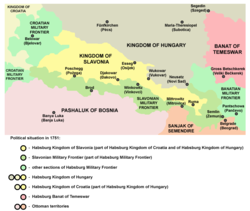
Back Каралеўства Славонія Byelorussian Regne d'Eslavònia Catalan Slavonské království Czech Königreich Slawonien (1699–1918) German Βασίλειο της Σλαβονίας Greek Reino de Eslavonia Spanish Slavoonia kuningriik Estonian Royaume de Slavonie French ממלכת סלאבוניה HE Kraljevina Slavonija Croatian
Kingdom of Slavonia | |||||||||||||||
|---|---|---|---|---|---|---|---|---|---|---|---|---|---|---|---|
| 1699–1868 | |||||||||||||||
 Kingdom of Slavonia in 1751, shown in yellow | |||||||||||||||
| Status | Lands of the Hungarian Crown (1102–1868)a Separate Habsburg land under joint civil-military administration (1699–1745),[2] Constituent land of the Austrian Empire (1804–1868)a Lands of the Crown of Saint Stephen (1868-1918) | ||||||||||||||
| Capital | Osijek 45°33′37.1″N 18°40′13.1″E / 45.560306°N 18.670306°E | ||||||||||||||
| Common languages | Official: Latin (until 1784; 1790–1847) German (1784–1790) Croatian (1847–1868) | ||||||||||||||
| Religion | Christianity | ||||||||||||||
| Demonym(s) | Slavonian | ||||||||||||||
| Government | Monarchy | ||||||||||||||
| Ban (Viceroy) | |||||||||||||||
• 1699–1703 | Adam Batthyány (first) | ||||||||||||||
• 1867–1868 | Levin Rauch (last) | ||||||||||||||
| Legislature | Sabor | ||||||||||||||
| Historical era | Early modern period | ||||||||||||||
| 26 January 1699 | |||||||||||||||
| 15 March 1848 | |||||||||||||||
| 26 September 1868 | |||||||||||||||
| Currency | Florin | ||||||||||||||
| |||||||||||||||
| Today part of | Croatia Serbia | ||||||||||||||
A: Subordinate to the Kingdom of Croatia (1745–1849), autonomous part of the Kingdom of Croatia and the Austrian Empire (1849–1868) | |||||||||||||||
| History of Slavonia |
|---|
 |
| History of Vojvodina |
|---|
|
|

The Kingdom of Slavonia (Croatian: Kraljevina Slavonija, Latin: Regnum Sclavoniae, Hungarian: Szlavón Királyság, German: Königreich Slawonien, Serbian Cyrillic: Краљевина Славонија) was a kingdom of the Habsburg monarchy and the Austrian Empire that existed from 1699 to 1868. The kingdom included northern parts of present-day regions of Slavonia (today in Croatia) and Syrmia (today in Serbia and Croatia). The southern parts of these regions were part of the Slavonian Military Frontier, which was a component of the Military Frontier separating the Habsburg monarchy from the Ottoman Empire.
- ^ "Austria-Hungary - Crown Lands, part II: Transleithnia and Bosnia & Herzegovina". FAME. Retrieved 12 March 2022.
- ^ John R. Lampe (1982). John R. Lampe; Marvin R. Jackson (eds.). Balkan economic history, 1550–1950: from imperial borderlands to developing nations. Indiana University Press. p. 63. ISBN 978-0-2533-0368-4.


